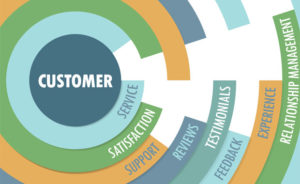I have never been a big fan of the term “360-degree view of the customer” for a couple of reasons, but mostly because you never can have a complete view of your customers. It’s simply impossible.
Things happen that you don’t capture in the data, as CRM at the Speed of Light author and all-around smart guy Paul Greenberg has pointed out. They get divorced, their dog dies, they get a really nice birthday gift. Those things can affect customers’ buying behavior. If you get a 240- or 250-degree view, you’re doing pretty well.
360-Degree View of the Data
However, you can and should develop a 360-degree view of your customer data, according to Paul. That is, you should be able to get your arms around all the data you’ve gathered about each customer, organize it, and view it in context.
That sounds simple, but over the last decade we’ve figured out way to sabotage this effort. The advent of the cloud made it easy for sales, marketing and support to implement systems that unintentionally rebuilt the silos that CRM was supposed to knock down.
This has resulted in what could be called “data sprawl”: The more customer data we capture, the more places it resides within the business.
The cloud — ironically, a phenomenon that Salesforce drove into mass acceptance — often took IT out of the equation, so by the time data sprawl was seen as a problem, the task of re-unifying the data was heavy lifting instead of a simple adjustment.
Add to that the desire of customers to communicate with the companies they buy from through whatever channel they think is best for what they’re trying to communicate — suddenly, the data is spread further, into more silos.
The data story about each customer becomes fragmented, isolated within departments, and incredibly difficult to assemble.
I’ve written about this very issue myself (notably, here and, more recently, here). That’s why I was so pleased to hear about Salesforce’s banner announcement for Dreamforce 2018, Salesforce Customer 360.
Often, big event announcements are solutions in search of a problem (or solutions in search of future software development). In this case, Salesforce is taking aim at a longstanding problem and delivering a solution laser-focused on solving it.
Salesforce’s Customer 360
The idea of Customer 360 is to collect all customer data in one place — and not just data from the various Salesforce clouds but also, through the MuleSoft Anypoint Platform, from other applications. The Anypoint Platform connects the applications’ APIs directly to Customer 360.
This is the secret sauce that makes the announcement really tasty, because it tackles a real-world issue. Almost no companies use an exclusively Salesforce stack for sales, marketing and service; Customer 360 helpfully pulls this data into the customer record.
The Salesforce part of the equation seems well thought out. After the APIs have been connected, a click-based user interface allows the management of the data to be mapped and reconciled. That creates a single representation of the data, avoiding the hazard of manually assembling the same data and possibly putting different priorities on different customer data each time the record is examined. Quite naturally, all of this can be viewed from within Salesforce.
This doesn’t mean that Salesforce is creating a massive new data lake or warehouse, which can challenge application performance and the user’s financial resources. Customer 360 leaves the data in its system of origin while also using a single ID for each customer; when the system pulls data for a customer, it’s the most recent data in the same sequence as in the past.
Salesforce is offering prebuilt packages for Customer 360 for service, marketing and commerce. That struck me initially as a little counter to the concept of a unified view of the data until I stepped back and put my user hat on: Yes, the data is the same, and the technology being used to deliver it is the same, but users of that data want it presented in a form that reflects their role and how they plan to use it.
Solves a Real-World Problem
This announcement should please IT managers, who will have a good starting place to untangle their data silos, but it’s also likely to please people who never see the Salesforce interface at all — customers.
The hazard of having a fractured view of customer data is that it creates a fractured experience for the customer — or, rather, prevents businesses from creating connected experiences for the customer.
Conversations carried out in chat may be separated from follow-ups that took place via email. Service histories and sales patterns may be contained in different systems. Payment details and patterns of buying may be tracked in different systems.
The effect for customers is that the business seems unable to understand who they are, no matter how many interactions they have with the business, and the customer experience suffers because of it.
After years of shows featuring drones, artificial intelligence, flashy analytical interfaces and other interesting if not always immediately impactful ideas, Customer 360 resolves a thorny real-world problem that can deliver a positive impact to business very quickly.
























































Social CRM
See all Social CRM